JR East Tōkyō-Area Passenger Locomotives
While most passenger trains in Japan are multiple-unit trains, either electric or diesel, there are still some trains consisting of cars hauled by locomotives. These trains are described on the Loco-Hauled Trains page. But the locomotives that haul them are worth attention in their own right.
Note: this page only describes locomotives used for passenger trains in the vicinity of Tōkyō in the JR era (post-1987), and may omit some from the earliest part of that range if they were quickly removed from service after JR East took over.
The locomotives used on passenger trains in the Tōkyō area are, as far as I can tell, exclusively electric locomotives, although the same train may be hauled by diesel when it is far from the city. Many of these are the same models used for freight, but I’ll list them here anyway, even though they’re also listed on the Freight page.
Locomotives other than industrial switches in Japan are given a model number based on propulsion, axle-count, and speed. A two-letter code is used, the first identifying their type (“D” for diesel, “E” for electric, and recently “H” for “hybrid” diesel/battery models) and the second number of powered axles (“D” for 4, “E” for 5, “F” for 6, “H” for 8), suffixed by a number to differentiate one from another, with numbers less than fifty used for locomotives with restricted top speeds, and higher numbers indicating locomotives capable of at least 110 kph. However, JR seems to be numbering all new models above 200. As all can do at least 110 kph this doesn’t alter the old numbering scheme, it just extends it.
Thus a DE10 is a low-speed (number less than fifty), diesel-powered (“D”), five-axle (“E”) locomotive. And an EF210 is an electric, six-axle, high-speed locomotive.
Note that axles are typically arranged in pairs, so a six-axle unit will have three trucks with two axles each, rather than two trucks of three axles as is common in the U.S. and Britain. Also note that because only powered axles are counted, there are a few six-axle locomotives of type B-2-B (two powered trucks with a center idler truck) that are identified as “D” rather than “F” (e.g., the DD51 and the ED76).
EF64-1000
JR East inherited 14 EF64 locomotives from JNR (JR Freight inherited 105, and the other JR’s inherited five more). Two series were made, the original (numbered 1 to 79) and the 1000 series (numbered 1001 to 1053). The 1000 series was an improved version, with substantial internal and external changes. If I’m reading the Japanese Wikipedia page correctly, JR East only inherited 1000-series models, although JR Freight received both the original and 1000-series.
The EF64 is still used on some passenger trains, and also sees use on the Chūō Main Line for freight duties. However, while wikipedia suggests they are not assigned to Tōkyō, they are used on passenger trains out of Ueno Station in Tōkyō (see large photo below). I have also seen recent online photos of them on Chūō Main Line intermodals in the metropolitan area. The JRF EF64s are gradually being replaced by the EH200, and JR East has discontinued some of the trains they were used on. Three of the JR East units and 48 of the JR Freight units have been scrapped as of 2008 (per Japanese wikipedia).
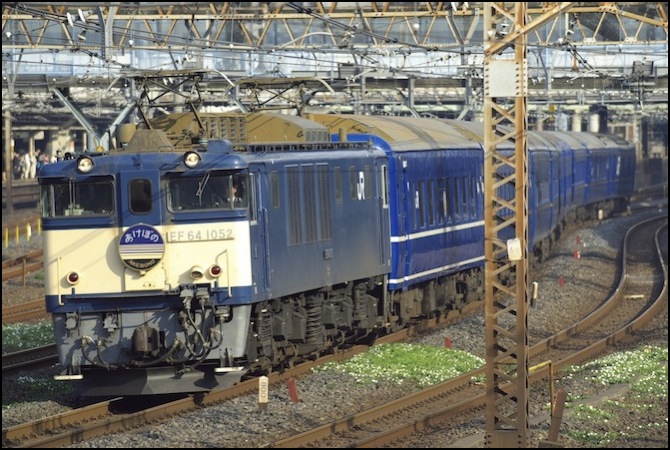
EF64-1052 with Akebono (2009)
Photographer: DD51612
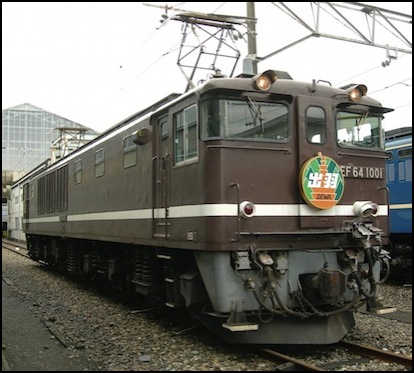
EF64-1001 at Takasaki Depot, with DEWA headmark (2009)
Photographer: Rsa
Specifications:
Type: EF64
Built: 1965 - 1982 (class prototype in 1964)
In use: 1965 - present (being retired)
Top Speed: 100 kph
Power: 2.55 MW (3,420 hp)
Type: electric, 1500 V DC catenary
Weight: 96 t
Use: Freight and Passenger (limited use)
Assigned: Tabata, Takasaki (Gunma prefecture), elsewhere?
EF65-1000
The EF65 is very similar in capability to the EF64, although they look quite different in detail. Three series were built, the EF65, EF65-500 and the EF65-1000 (train numbers reflect the series). Examples of all remained in use until recently. However, the EF210 is largely replacing the remaining freight units.
The EF65-500 series was designed for high-speed passenger and freight trains, and two subseries (identified as “P” and “F”) were built. The EF65 and EF65-1000 series were general-purpose, and used for both passenger and freight.
Unit 1118, one of two JR East EF65-1000 units painted red for a Super-Express passenger train discontinued in 2000, is now assigned to Tabata Depot and used for work trains and freight (the other unit was scrapped).
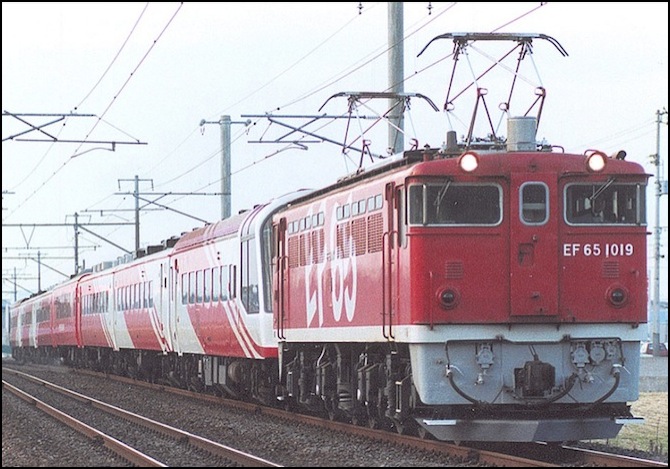
JR East EF65 #1019 leading Rainbow (unknown)
Photographer: spaceaero2
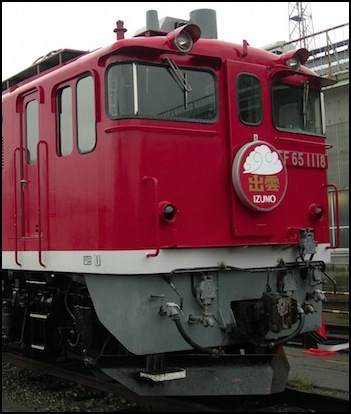
JR East EF65 #1118 at Tōkyō Oku Depot (2007)
Photographer: Rsa
Specifications:
Type: EF65
Built: 1965 - 1979 (all EF65 subclasses)
In use: 1965 - present (being retired)
Top Speed: 110 kph
Power: 2.55 MW (3,420 hp)
Type: electric, 1500 V DC catenary
Weight: 96 t
Use: Freight and Passenger
Assigned: Tabata, elsewhere?
EF81
The EF81 is a dual-voltage locomotive, and with 50/60 Hz support one that can run in both regions of Japan (west and north). The dual-voltage capability makes them useful on the Jōban line, which becomes an AC line at Fujishima, 46 km from Tōkyō’s Ueno Station. Several different series were produced, some for specialized tunnel use in Western Japan. Although JR Freight owns many of these, they appear to all be assigned to Toyama Depot, for use along the Sea of Japan coast (per the Japanese Wikipedia page). JR East inherited 78 of them when JNR was broken up. There is at least one assigned to Tabata Depot, and any there would include JR East units used on passenger trains originating from Ueno, such as the Akebono seen below. The ones assigned to the Cassiopeia and Hokutosei were replaced in the summer of 2010 by EF510-500 locomotives; it is unclear if they are still used on Akebono, the third “Blue Train” out of Ueno.
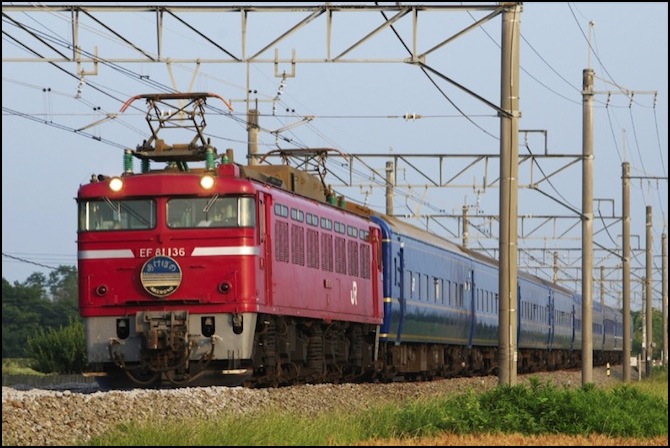
JR East EF81 #136 leading Akebono (2007)
Photographer: Sui-setz
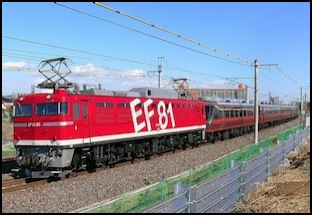
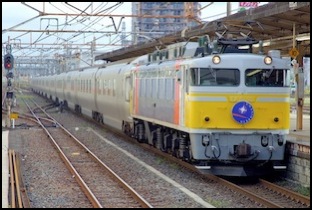
L: JR East EF81 #95 (2007); R: EF81 #92 on Cassiopeia at Utsunomiya (2007)
Photographers: まも (Mamo), 出々 吾壱
Specifications:
Type: EF81
Built: 1968 - 1979, 1989 (series 500), 1991 (series 450)
In use: 1968 - present
Top Speed: 110 kph
Power: DC: 2,550 kW (3,420 hp), AC: 2,370 kW (3,178 hp)
Type: electric, 1,500 V DC / 20 kV AC (50/60 Hz), catenary
Weight: 100.8 t
Use: Freight and Passenger
Assigned: JR East: Tabata Depot, elsewhere; JR Freight: Toyama Depot
EF510-500
The EF510 is the dual-voltage version of the EF210, introduced by JR Freight in 2001. The 500 series was introduced in 2010 by JR East for passenger train use, and is the first electric passenger locomotive introduced by a JR group (all other passenger locomotives date from the Japanese National Rail era, before 1987). The first eight (501-508) wear the blue livery, and two more (509-510) have been built in a silver livery to match the Cassiopeia cars. A total of fifteen are planned to be built.
The EF510-500 was introduced to haul the Hokutosei and Cassiopeia trains (no mention of the third blue train, Akebono is made, so perhaps that will continue to use EF81s). It’s unclear if these are to be used elsewhere. Also, the train is apparently not equipped with the safety equipment required for use in the Seikan tunnel between the main island of Honshu and the northern island of Hokkaido, and lacks the 25kV support that will be needed once the tunnel is converted to dual-gauge track for use with the Hokkaido Shinkansen, meaning that some other locomotive must be used through the tunnel. The wikipedia page for the Hokutosei says that this locomotive was only used to Aomori, at the northern end of the main Japanese island of Honshu.
The wikipedia page for the Hokutosei notes that an EF81 based in Tabata Depot was formerly used to haul the train to Aomori, where a JR Hokkaido ED79 took over to Hakodate (i.e., through the tunnel), and a DD51 diesel to Sapporo. The EF51-500 replaced the EF81 as of 14 July 2010.
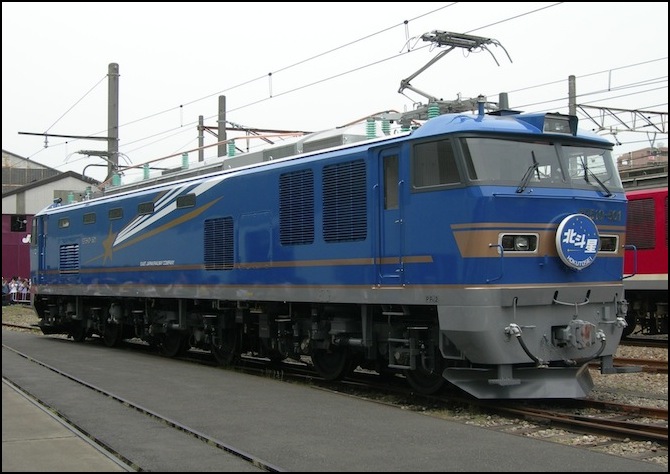
JR East EF510-501 at Omiya with Hokutosei headmark (2010)
Photographer: Rsa
Specifications:
Type: EF510-500
Built: 2010-2011
In use: 2010+
Top Speed: 110 kph
Power: 3,390 kw (4,546 hp)
Type: electric, 1,500 V DC / 20 kV AC (50/60 Hz), catenary
Weight: 100.8 t
Use: Passenger
Assigned: JR East: Tabata Depot (Hokutosei and Cassiopeia sets), elsewhere?




